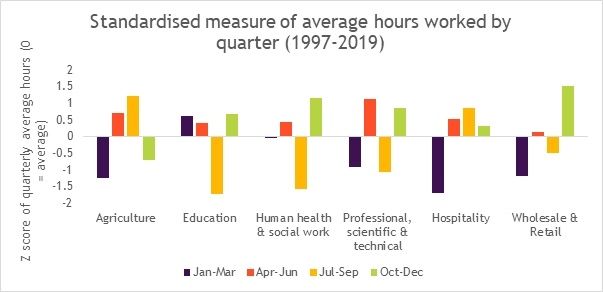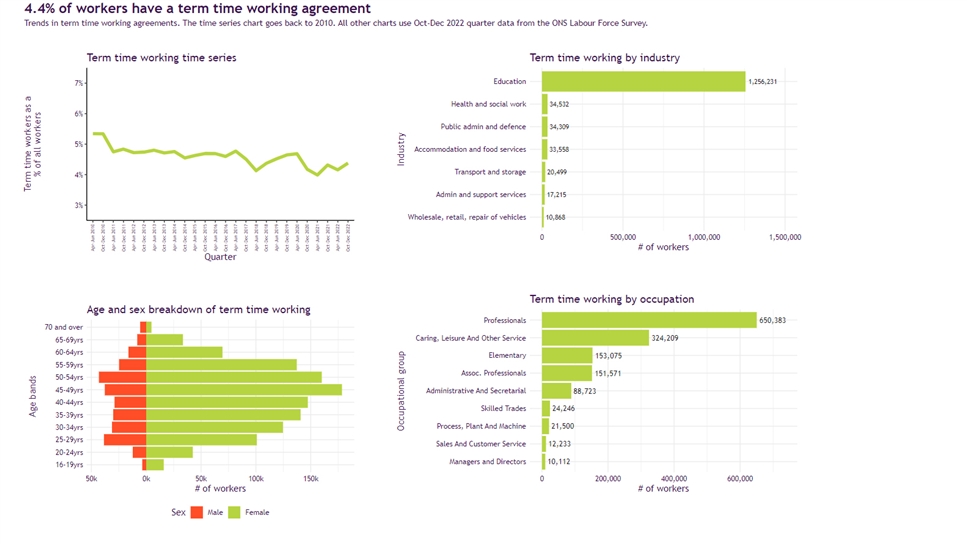Jon Boys, Senior Labour Market Economist at the CIPD, analyses seasonal variations in working hours and discusses flexible working practices that can benefit both the employer and the employee
In 2022, PwC grabbed headlines by offering staff summer hours. This meant employees could leave the office at midday on Fridays between June and August. PwC didn’t call their summer hours a four-day week (this was at the time when many companies were trialling this) but it was, in substance, a seasonal equivalent. After all, those on the official four-day week trial saw average hours decline from 38 to 34 hours a week (so closer to 4.5 days).
Many organisations face high seasonal demand and summer hours are but one way to manage this. This blog explores how average hours differ by season in many industries and what flexible working opportunities organisations can use to manage these variations. Many have been doing this for years. Such practices can be a win-win for both employers and employees: the employer gets to use the employees’ time more efficiently by not paying them to be idle, and the employee may value the time given in the summer more highly than the time taken during the darker months.
Seasonal variations by industry
The chart below looks at five industries with seasonal demand and compares a standardised measure of average hours per quarter. We see that hours worked in agriculture peak in the summer during harvest, while education troughs at this time when the schools are closed. The health sector peaks in autumn/winter, while hospitality has a peak in summer. Even in industries where we might not expect much seasonal variation there is some, such as in professional, scientific and technical activities (which includes PwC). This broad group actually has two peaks and two troughs.

Source: HOUR03: Average hours worked by industry
So what flexible working options can organisations offer their staff to manage these variations?
Term-time working
One obvious example which is used almost exclusively in education is term-time working. This is popular among women and, at 4.4% of workers, covers a significant percentage of the workforce. In recent weeks Amazon announced that staff would be able to do term-time working. Ostensibly this is presented as a win for the employee and flexible working but, as the chart above shows, there is a lull in demand in wholesale and retail between July-September with the major busy period being the lead-up to Christmas. More term-time working is probably a win-win for both Amazon and its employees as it helps manage this seasonal demand.

Annualised hours
Another common form of flexible working is annualised hours, which over one in 20 (5.4%) of workers use. Under this arrangement, a worker has a set number of hours of work within the year but may work more or less on a given week in order to meet demand. The largest numbers of people using this form of flexibility are in the health and social work sector. In this instance, demand is seasonal because more people get sick in the winter months.

Flexi-time
A very significant 13.5% of workers use flexi-time as a way of working. Flexi-time offers workers the chance to decide the start and end times of their day as well as their breaks (though often within certain limits). By working overtime, workers can sometimes accrue days in lieu, perhaps as many as 12 a year. The public administration and defence industry has the highest number of people using this form of flexible working.

Temporary contracts
Another strategy is to hire people only when you need them is using temps. This form of employment used to have a highly seasonal element to it in. However, the pattern has broken down in recent years. It is perhaps the extra cost premiums of hiring temps, and the loss of firm-specific know-how from short employment contracts that have made this strategy of managing seasonal demand less appealing to businesses.

A range of options are available for organisations to manage seasonable demand. Those with the most extreme fluctuations including education, healthcare and hospitality have found ways that work for their industries. But many organisations will find reduced demand in the dog days of summer. People in all industries get sick more in the winter, and have childcare commitments and holidays in the summer, so most jobs will have some ebb and flow to the workload throughout the year. Your fluctuations may not be as extreme as other industries and thus a policy like summer hours - leaving early on Friday for a time-limited period - could prove a good proposal.
The pandemic opened the door to the idea that work was something you do, not somewhere. While headlines about summer hours and four-day weeks may sound like something new, many organisations have been employing flexible working in a mutually beneficial way with their employees for some time.
For more information on flexible working options and recommendations, see these CIPD resources:
